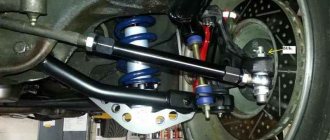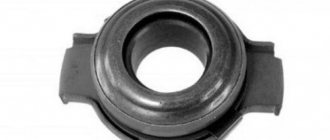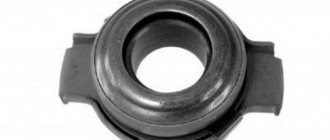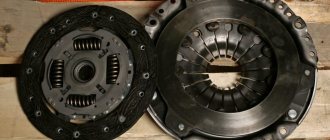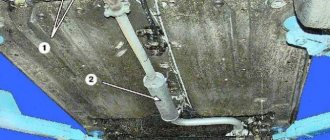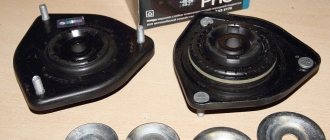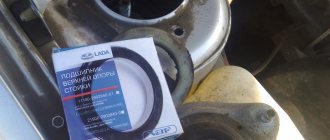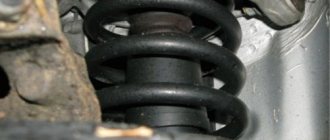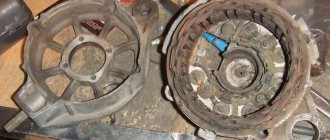When malfunctions occur in the front suspension of a car, one of the first measures that its owner should take is check the support bearing, located between the support and the upper spring cup. To do this, you will need to grab the “cup” of the rack with your hand (put your hand on the support) and rock the car. Constant, sharply changing loads, including shock loads in combination with abrasive dust particles, contribute to the wear of the components of the support strut bearing and ultimately completely disable it. As a result, it begins to play, knock, squeak or squeak, and the shock absorber rod deviates from its axis.
Diagram of the support bearing operation
Such problems with its operation can lead to more serious consequences in the car’s suspension. Since wear of the support bearing will lead to a violation of the wheel alignment angles, and consequently, a deterioration in the car’s handling and accelerated tire wear. How to check and which manufacturer of thrust bearings to give preference to when replacing - we will tell you about all this in more detail.
The important role of MacPherson struts
But MacPherson struts have another important function - they also serve as steering knuckles. That is, the stand with the wheel hub attached to it can rotate around an axis, which allows the drive wheels to be steered.
Naturally, where there is rotation, a bearing is used; in the case of this type of suspension, a support bearing.
To figure out where the support bearing is installed, let's briefly look at the car suspension structure.
Its main components are:
- Shock absorber.
- Frame.
- Spring.
- Support.
All these elements are assembled into a single whole, which provides the possibility of compressing and decompressing the spring and moving the shock absorber rod in the body (which is what the suspension is actually for, since vibrations are damped during these movements).
To ensure all this, the rack is assembled like this: a shock absorber is installed in the body and all this is installed in a spring.
To support the spring from below, a cup is used, attached to the body (welded to it).
To ensure that the spring is pressed, another cup is installed at the top, which rests against the support.
The spring extension limiter is the shock absorber rod, a limit switch that passes through the support and is secured with a nut.
Additionally, the support not only acts as a stop for the spring, it also provides the upper fastening of the strut to the body (it is attached to it with levers from below).
The main causes of vibration in the steering wheel
Among the popular reasons that cause a slight knock in the front suspension on small bumps is a large gap between the steering rack and gear. This is the result of wear and tear. To make an accurate diagnosis, it is recommended to pull the steering rods up and down. At the same time, carefully observe the movement of the rod. If she doesn't move, then she's fine. If the rod dangles, then most likely the bushings are worn out.
If the rack turns, then the accurate diagnosis is a large gap in the engagement. But this problem can be easily eliminated by tightening this very rail. Also, when pulling the steering rod, you may notice broken or overly worn bushings securing the steering rods to the steering rack.
Another possible cause of knocking is the steering joint. Testing this hypothesis with both hands will be quite difficult. You'll need a friend's help. The assistant must turn the steering wheel very quickly and sharply, and the car owner must grasp the hinge in such a way as to hold the hinge itself, its body and finger. If there is wear, you can feel the play. Then suspension repairs will not be necessary in the near future, and you will only have to buy and replace the hinge bushing.
Where is the support bearing installed and what function does it serve?
It is noted above that the MacPherson strut also acts as a steering knuckle. From below, rotation around the axis is ensured by a ball joint, through which the levers are attached to the rack.
If the upper strut support were not a limiter for the spring, then there would be no problems with rotation (the shock absorber rod can rotate freely).
But the spring, being in a preloaded state, creates a fairly strong force on the cups, and as a result on the support, which is rigidly attached to the body.
Therefore, a support bearing is installed between the support and the upper spring cup.
Thanks to this design solution, under the influence of the steering mechanism, the stand (assembled) can rotate around the axis, while the support remains motionless.
It is precisely the support bearing that provides the ability to rotate the shock absorber strut.
Steering
Even for experienced service engineers from numerous car repair shops, finding the cause of extraneous knocking noises is a serious problem. Many people immediately recommend replacing the shock absorber strut. Here it is, new, on the car, and the strange knocking noise in the front suspension on small bumps has not gone away. The car owner goes to another service center, but there they offer him to replace the support bearing, but even after that the knocking noise does not disappear.
When diagnosing the front suspension, experienced car owners begin checking with the steering system.
Types of bearings
There are two design versions of the upper part of the rack:
- The support bearing is included in the support design (can be found on a number of VAZ models);
- It is a separate element that is placed between the support and the upper spring cup.
But there are several support bearings themselves that are used in the suspension design:
- WITH BUILT-IN OUTER OR INNER RING. Its peculiarity lies in the possibility of rotation of elements that are in contact with both the outer and inner rings. Additionally, this option provides installation holes, so no pressure flanges are needed during installation;
- WITH DETACHABLE OUTER OR INNER RING. In this embodiment, one of the rings (depending on the design) can be separated, while the second is fixed to the support;
- SINGLE-SPLIT. Structurally, this option is the same bearing with a detachable ring, but has increased rigidity.
In general, there is no particular difference which type of bearing is used, the main thing is that it performs its functions.
Despite the fact that the upper part of the strut is installed inside a special niche in the wheel arch, dirt, sand and dust penetrate the support, and these contaminants are destructive to any bearing.
Additionally, the support bearing is almost constantly subjected to rapidly changing loads, including shock loads (due to the operation of the spring), which, in combination with contamination, leads to intense wear of the bearing components and its failure.
Due to rather difficult operating conditions, the service life of such a bearing is limited. Many manufacturers indicate that it must be replaced every 100 thousand km.
But in reality, due to the poor condition of the roads, they require replacement after 50 thousand km. At the same time, the resource of this node also depends on its quality.
It is not uncommon for a support bearing to be replaced after 10,000 km.
Bottom line
It is worth understanding that partial or even complete failure of the support bearing is not a critical failure for the car. However, this does not mean that you can safely drive such a car. In addition, in domestic realities it is better to carry out diagnostics every 10-20 thousand kilometers. It doesn't matter whether there are signs of a malfunction or not. This approach will first of all allow you to save on repairing other elements of the car’s suspension. This applies to shock absorbers, springs, protectors, tie rod ends and the rods themselves. In order to slow down wear, you need to remember to change the oil on time.
You need to maintain your car regularly, otherwise you can become an example of careless and dangerous “care” for your car. And that's not very fun.
Consequences of bearing wear and signs of damage
Since the support bearing can be partially attributed to the steering (without it, rotation of the rack would be impossible), its failure primarily affects the controllability.
But here it should be noted that this depends on the design solution used.
For example, in a VAZ-2110, the inner race of the bearing acts as a bushing through which the shock absorber rod passes.
As a result of critical wear of the bearing, it begins to play and the rod is able to deviate from the axis.
The result of this is a violation of the wheel alignment angles, and consequently a deterioration in the car’s handling, as well as accelerated tire wear.
But on a car, where the bearing only provides rotation of the strut and does not interact with the shock absorber, alignment violation practically does not occur, since the rod is kept from axial displacement by a bushing pressed into the rubber damper.
But even with this design, bearing wear will have a negative impact on handling.
If the bearing has worn out, this will naturally begin to show. In this case, the symptoms of a malfunction depend on the design.
If we take the same VAZ-2110, then bearing wear will manifest itself in the form of knocking noises when driving over potholes and unevenness on the road; in addition, they can be heard when turning. Sounds in the support are caused by play in the support element; it is important not to confuse them with a knock in the shock absorber.
In the case of a bearing that does not interact with the shock absorber, its malfunction most often manifests itself in the form of squeaks and squeaks when turning.
How to check the supports
Supports, like any car part, are subject to wear. Over time, the characteristics of shock absorbers gradually deteriorate, but the driver does not immediately notice this, as he adapts his driving style to the characteristics of the car. This diagnostic method involves a subjective assessment of the wear state of shock absorbers. The assessment is based on the deterioration of vehicle characteristics.
Different brands and models of cars have different parameters of stability, handling, and suspension stiffness, which are incorporated into them at the design development stage. Also, each driver has his own driving style and ideas about the required suspension stiffness. Therefore, these concepts are quite relative and in each case individual in nature.
Many diagnostic methods, although capable of assessing underlying bearing problems, are considered highly subjective. Most manufacturers, in their recommendations for troubleshooting these parts, advise using this method to compare the “behavior” of a car with a specific model, that is, with an absolutely identical car equipped with good bearings. Of course, in practice this is not always possible.
How to determine a faulty shock absorber support - basic methods
It is not difficult to determine the malfunction. The main sign of a breakdown is a strong knocking sound near the front left or right side members. The sound may also be caused by other suspension elements. You should check it from the “support”.
On level ground
The front strut bearing can be checked on a flat, straight surface. Here's how it's done:
- You need to park on level ground.
- Raise the riser.
- Open the hood.
- Remove the glass protection.
- Press firmly on the support device with your hand.
- An assistant will rock the car.
- If there is play in the support bearing, it will need to be replaced.
While driving
You can check the strut support bearing while driving. Various sounds are especially noticeable when driving on uneven roads. Malfunctions will be noticeable when driving through potholes and on sharp turns. This is the best way to check the journal bearing. When driving with a faulty bearing, the car will “yaw” a lot.
Steering wheel rotation
It is very easy to notice a faulty support bearing when turning the steering wheel. A strong knocking sound will be heard from the support bearings.
Verification methods
Checking the condition of the support bearing is not difficult, but the technology depends on the design features of the rack itself.
It is worth noting here that such a check will not give an accurate result; you can verify that the bearing is faulty only after removing it from the car.
But, nevertheless, by performing a number of simple steps you can determine the condition of the upper support.
If we take the VAZ-2110 model, then its support bearing is installed in the support itself.
To check its condition, you should ask an assistant to rock the car in the transverse direction (not too much), while at this time we place our hand on the protruding part of the pillar in the engine compartment.
If the bearing is worn out, play will be felt by hand. Also, in a damaged element, such rocking is usually accompanied by the appearance of third-party sounds - creaks, clicks.
If all this is found during the inspection, it’s time to inspect the support.
On models such as Lada Priora, Lada Kalina, or, for example, Nissan X-Trail, the bearing is not included in the support structure, so it cannot be checked by rocking it. The only sign of wear is the appearance of a knocking sound when driving.
But it is still possible to further verify that the unit is faulty.
To do this, ask an assistant to turn the steering wheel in different directions. At the same time, we put our hand to the spring.
If the bearing is heavily worn, then wedging may appear in it, which will be reflected well into the spring in the form of vibration and mild “shooting”.
Read about the reasons why you hear a knocking sound when turning the steering wheel.
Diagnostics of bearing units
It is important to detect the first signs of wear on the elements in time - this will give you a small margin of mileage before replacement. Determining how a bearing hums is quite simple: remember the sound of an accelerating electric train or subway train and compare it with the noise of a car's chassis.
Comment. Do not confuse the hum of worn-out hub mechanisms with the howl of “rogue” transmission units - the gearbox and rear axle gearbox. The sounds are very similar, but the transmission howls in certain modes - under load (acceleration), or vice versa, after releasing the accelerator pedal. The wheel bearing is constantly noisy.
At the first stage of wear, the humming sound of bearing mechanisms appears at a speed of 40–50 km/h and increases as the vehicle accelerates. Later, a crackling and knocking sound is added to the hum, indicating partial destruction of the separator and the rollers falling out. At the last stage, the part falls into pieces, the wheel jams or turns across the road, which poses a great danger to car passengers and nearby pedestrians.
How to find out where a wheel with a bad bearing is located:
- First, listen carefully to where the sound is coming from - from the front or rear axle. If in doubt, check the noise change during a sharp turn. A bad front hub part will make a louder noise.
- Having eliminated 2 serviceable wheels, proceed to diagnosing the remaining hubs. Lift each side of the car one by one, hang the wheels and manually try to swing them along the axis of rotation in the vertical and horizontal plane. An increased backlash will indicate a worn part (small play is quite acceptable).
- To prevent wheels from wobbling due to broken ball pins, have an assistant press the brake pedal while checking. The play has disappeared - the bearing is definitely to blame.
- Rotate the suspended wheel quickly. If you hear extraneous knocking noises or rotation requires some effort, the problem is in the bearing assembly.
- The deterioration of the cage and rollers causes vibration, which is felt by touching the hub with your hand as the wheel rotates.
It is quite difficult to determine by ear which bearing has finally worn out when two parts located on different axes fail at once. The hum comes from both sides, it is impossible to localize the fault. There are two ways to clarify the location: hang and check all the wheels one by one, or use a service station lift.
A faulty bearing mechanism always heats up more intensely than the rest . If you hear a humming noise while driving, stop and feel the hub nut caps to compare the temperature. Unfortunately, this method is not applicable when decorative caps are installed - by the time you remove them, the metal parts will cool down.
Spherical bearing
On car forums, in topics dedicated to this knock, a variety of reasons for knocking in the front suspension are discussed. Ball joints are one popular reason. One can say even more - this is a classic among all possible sources of extraneous knocks.
But there is one peculiarity here. On front-wheel drive cars, knocking noises from ball joints are very rare. It is more typical for classic VAZ models.
Thus, a worn joint can cause sharp vibrations when crossing small irregularities in the road. It is quite easy to diagnose this malfunction - pull the front wheel in a transverse direction. Naturally, it is advisable to lift the car for this. Beginners may confuse play in the ball joint with wheel bearing movements. In this case, the assistant must hold the brake before pulling the wheel, this will eliminate the hub play.
Sometimes an extraneous knock can be caused by a real trifle - check the rubber boots. Hinges cannot last long if the protective cover is torn.
Rear suspension
Rear axle rods.
On rear-wheel drive cars, when starting and braking, a knocking sound is often heard due to wear on the bushings. Or, after sharply pressing the gas pedal, the rear of the car is pulled slightly to the side - the direction of movement of the car has to be corrected by the steering wheel. The faulty rod needs to be replaced.
Rear brakes.
When you press the brake pedal, is there a noise or vibration throughout the body? This is a common problem in wet weather. This is usually due to a thin layer of corrosion or dirt on the pads or the inside of the brake drums. In this case, try driving a hundred meters with the handbrake slightly extended - the layer of corrosion will disappear as a result of friction.
Can new shock absorbers make knocking noises?
A knocking sound from a recently installed rear shock absorber is not uncommon. But car enthusiasts pay attention to new dampers last, first of all, suspecting other elements of the chassis as the source of the knocking. Even newly installed devices can make noise. Possible reasons:
- the product is defective;
- violation of fastening;
- the bushing does not meet the specified parameters.
Manufacturer defects are a rare occurrence, but they should not be discounted. Much more often, knocking occurs due to poor-quality fastening of the device. The movement of the damper along the rack is accompanied by a knocking sound if the nut fixing the element is poorly tightened or loosened during operation. In lever suspensions, knocking can occur due to deformed bushings mounted in the mounting lugs.
Why does the knock occur?
Possible causes of shock absorber knocking:
- oil leaks;
- the body is damaged;
- the piston rod is deformed;
- Low quality oil is poured.
If oil is leaking, it means it’s time to change the gaskets, as they have ceased to provide a tight seal. The reasons for this include natural wear (the edge adjacent to the rod can wear off due to constant movement) and damage caused by corrosion or the formation of dirt deposits in the rod.
The casing may become deformed if it is subjected to repeated impacts. Dents will become a serious obstacle to the movement of the rod inside the tank. The rod will constantly rest against the bulge, which will cause a knock. But this problem only occurs in single-pipe devices. In two-pipe systems, only the outer tank receives mechanical damage, while the inner one remains unharmed. The shock absorber may be poorly secured in the strut housing. Then its movement causes cracks to form. The piston is damaged if the car falls into a hole at high speed. It hits the bottom of the tank, causing damage to the piston. Because of this, the valves are damaged and the normal flow of the working fluid is disrupted.
The condition of the damper depends on the quality of the oil. Its viscosity must be sufficient to create normal resistance to the piston stroke. In winter, the viscosity of the oil increases, which makes its resistance too high.
